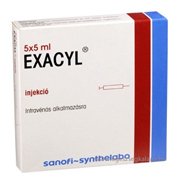
Hypersensitivity reaction may occur in rare instances and may warrant discontinuation of the medication. Dermatological manifestations like itching of exanthema may be reported rarely.
Use In Pregnancy
- Animal reproduction studies have not shown any evidence of impaired fertility or side effects on the fetus after the administration of Exacyl.
- Exacyl (tranexamic acid) crosses the placental barrier and cord blood concentrations are approximately equal to maternal concentration. Since there are no adequate and well-controlled studies in pregnant women, Exacyl should only be used during pregnancy if clearly needed.
Nursing Mothers
Exacyl (tranexamic acid) is secreted in the mother’s milk. Therefore it should be administered with caution in nursing women.
Pediatric Use
The limited data suggest that dosing instructions for adults can be used for pediatric patients needing Exacyl therapy.
Overdose
Symptoms of over-dosage may be nausea, vomiting and hypotension. There is no specific antidote. General measures should be taken to manage a case of Exacyl over-dosage.
Leave A Comment